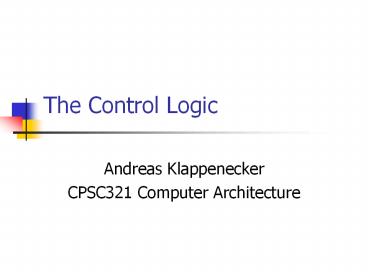The Control Logic PowerPoint PPT Presentation
Title: The Control Logic
1
The Control Logic
- Andreas Klappenecker
- CPSC321 Computer Architecture
2
Verilog HDL
3
Verilog Programming
- Suppose that we have a module foo
- Our goal is to instantiate and wire a module foon
that contains n copies of the module foo. - Many textbooks on Verilog suggest to write down
the n instance explicitly - if n 1024 then this is not a viable option
- reusability of the code would be limited
4
Example 1
foon
5
Example 1
- module foo(out, a,b)
- output out
- input a, b
- xor (out, a, b)
- endmodule
module foon(out, a, b) parameter n 8
output n-10 out input n-10 a, b foo
foonn-10(out,a,b) endmodule
6
Example 2
foon
7
Example 2
- module foo(out, a,b)
- output out
- input a, b
- xor (out, a, b)
- endmodule
module foon(out, a, enable) parameter n 8
output n-10 out input n-10 a input
enable foo foonn-10 (out, a,
outn-20,enable) endmodule
8
Remarks
- The module vector operator is not available in
Icarus Verilog nor in Veriwell - The features shown work in vcs
- foo foonn-10(out,a,outn-20,enable)
- out and a range over n-10
- outn-20, enable gives vector n-10
- The suggested for-loop construction does not work
9
Control
10
MIPS Multicycle Datapath
- Incomplete (branch and jumps)
11
Control
- What are the control signals?
- Finite state machine control
- Instruction fetch
- instruction decode
- memory reference
- R-type
- branch
- jump
12
Multicycle Datapath and Control Lines
13
(No Transcript)
14
High-Level Picture
- What happens precisely during each step of
fetch/decode/execute cycles - Construct the finite state control machine
- High-level view
15
Instruction Fetch/Decode/Execute
16
(No Transcript)
17
(No Transcript)
18
(No Transcript)
19
(No Transcript)
20
(No Transcript)
21
(No Transcript)
22
(No Transcript)
23
Instruction Fetch Decode FSM
24
Memory-Reference FSM
- Address calculation
- Load sequence
- read from memory
- store to register
- Access memory
- Store sequence write
25
R-type Instruction
- Execution of instruction
- Completion of instruction
26
Branch Instruction
27
Implementation of FSM
- A FSM can be implemented by a register holding
the state and a block of combinatorial logic - Task of the combinatorial logic
- Assert appropriate signals
- Generate the new state to be stored in the
register
PowerShow.com is a leading presentation sharing website. It has millions of presentations already uploaded and available with 1,000s more being uploaded by its users every day. Whatever your area of interest, here you’ll be able to find and view presentations you’ll love and possibly download. And, best of all, it is completely free and easy to use.
You might even have a presentation you’d like to share with others. If so, just upload it to PowerShow.com. We’ll convert it to an HTML5 slideshow that includes all the media types you’ve already added: audio, video, music, pictures, animations and transition effects. Then you can share it with your target audience as well as PowerShow.com’s millions of monthly visitors. And, again, it’s all free.
About the Developers
PowerShow.com is brought to you by CrystalGraphics, the award-winning developer and market-leading publisher of rich-media enhancement products for presentations. Our product offerings include millions of PowerPoint templates, diagrams, animated 3D characters and more.

